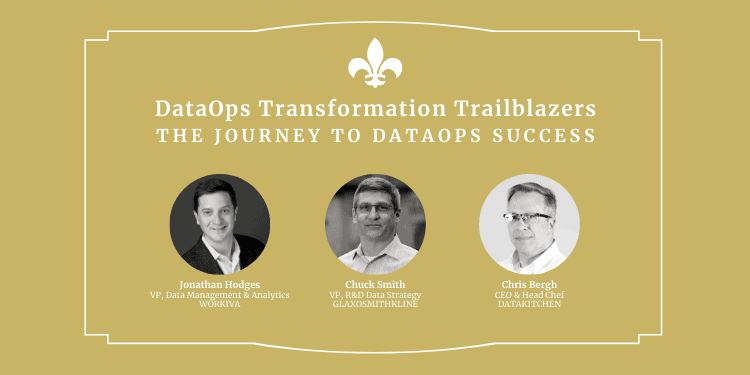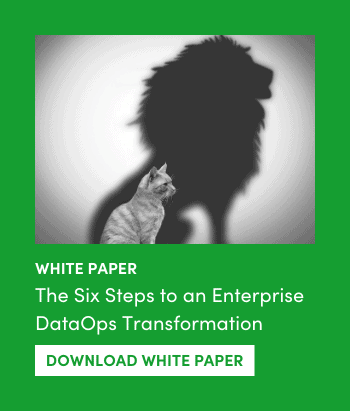In early April 2021, DataKItchen sat down with Jonathan Hodges, VP Data Management & Analytics, at Workiva; Chuck Smith, VP of R&D Data Strategy at GlaxoSmithKline (GSK); and Chris Bergh, CEO and Head Chef at DataKitchen, to find out about their enterprise DataOps transformation journey, including key successes and lessons learned. You can listen to the entire conversation here or read the summary below
DataOps Driven by Need for Greater Agility and AI/ML adoption
All of the panelists discussed how their increasing need for agility created urgency for DataOps at their organizations. GSK had been pursuing DataOps capabilities such as automation, containerization, automated testing and monitoring, and reusability, for several years. However, the organization was reaching a tipping point where their technologies and processes were becoming capacity constrained. As a result, they invested in a DataOps Platform to scale their efforts more broadly. Furthermore, the introduction of AI and ML models hastened the need to be more efficient and effective in deploying new technologies.
Similarly, Workiva was driven to DataOps due to an increased need for analytics agility to meet a range of organizational needs, such as real-time dashboard updates or ML model training and monitoring. According to Hodges, “I’m never going be able to go out and hire an army. There are a limited number of folks on the data team that can manage all of these things. The trends are stacked up against the data team and we started to realize that there had to be a better way.”
To Get Started, Find Your Biggest Pain Point
To get started with DataOps, Bergh advised, “You have to find the area that you have the most pain. Some people have relatively good data, so errors are not necessarily a problem. Other teams take months to deploy. Others have difficulty collaborating. Most people want all three – they want to have fast cycle time and low errors and solve the ‘Hatfields and McCoys’ collaboration issue. And so, it’s really about finding a specific pain case first – one that’s tractable that you can solve, and then use that as leverage to get to the next problem.”
At Workiva, they recognized that they are only as good as their data, so they centered their initial DataOps efforts around lowering errors. Hodges commented, “Our first focus was to up our game around data quality and lowering errors in production. We prioritized mission-critical ETL pipelines and senior leadership dashboards – the types of things you never want to get the call when they go wrong.” Workiva also prioritized improving the data lifecycle of machine learning models, which otherwise can be very time consuming for the team to monitor and deploy. DataOps provides the “continuous delivery equivalent for Machine Learning and enables teams to manage the complexities around continuous training, A/B testing, and deploying without downtime. Automating these processes frees up the team’s time to focus on developing new models and use cases.”
GSK’s DataOps journey paralleled their data transformation journey. GSK has been in the process of investing in and building out its data and analytics capabilities and shifting the R&D organization to a software engineering mindset. The sheer scale of this effort (there are almost 90 different product teams that need analytics pipeline support) meant that success required an underlying platform for standardization with “the quality checks, the automation, and the reusability and repeatability and containerization wrapped into it.”
The Biggest Challenge is Not Technical
The panelists agreed that the biggest hurdle to DataOps is not technical, but instead is about creating a mindset shift within the organization. At GSK, the team needed to shift from its traditional waterfall-based approach. Smith explained, “We knew how to do data, we’ve done it our whole lives. It took a long time for us to get our heads wrapped around how to drive value leveraging DataOps. Partners and engineers across the company still struggle today because it is such a significant mindset shift.”
At Workiva, an obstacle was describing the challenges that data people face to non-data people, including senior leadership, and getting them to buy-in. A common question was, ‘Why can’t you just build this yourself?’ The data team needed to explain that,
“Building a DataOps system could take years of effort, which is time not spent delivering value for our customers. It’s a classic build-vs-buy option, where there is something very robust in the marketplace that is off the shelf and can orchestrate the tools we already have today.”
Define the Value Proposition to Influence Others
Because DataOps is such a new concept, all of the panelists agreed that it is difficult to influence others and convince them to work in a different way.
At GSK, repetition was critical to success. According to Smith, “It is about helping people understand the value proposition. When you see a bottleneck in a process or you have a significant amount of time that it takes to get new analytical capabilities into production, you can work your way back into a value proposition that talks about a different way of doing things.”
At Workiva, Hodges found analogies to software engineering to be extremely helpful for convincing leadership. “Our software development group was reaping benefits out of some tools that they had just purchased to help them do things like CI/CD and Observability. These were useful analogies because our leadership understood this value proposition.” He also found it helpful to highlight the costs associated with errors and downtime and the upside of improved productivity.
Multiple Metrics for Success
At GSK, success is all about adoption. “Success is ensuring that we’ve got analytics being built consistently across 90 product teams in support of their particular analytical needs and it’s done in a consistent way.”
Workiva uses a broad range of metrics to measure success. The organization had already established a good baseline of data on metrics, such as outages, and development and deployment time prior to implementing DataOps, so will be able to measure efficiency gains. Another important metric the team is using is a breakdown of the team’s work. By categorizing the type of work being done in JIRA, they hope to show that “we actually are focused on more things that are growth-related or have a higher value to the organization than chasing our tails, trying to figure out why a dashboard is wrong.”
Bergh also suggested that companies think about what percentage of their pipelines are following DataOps principles, meaning they employ testing, automation, and collaboration. Ultimately, this means that they are working in a better way.
Early Results are Positive
Although both organizations are early in their DataOps journey, they are experiencing positive results. At GSK, the results from its early deployment of DataOps have been significant, particularly as it relates to automation. At Workiva, anecdotal early results are also very encouraging. In particular, the team is more confident when jobs are running. “It is a huge productivity win that someone on the team no longer needs to constantly log in and monitor runs.” Hodges added,
“I think you’ll see a culture shift toward feeling confident. I used to feel very, very careful around changing anything data-related, and I think you’re starting to see that that’s not that big a deal anymore, because [if something goes wrong] we can now figure out what happened pretty quickly, and we can adjust it. That is going to lead to more innovation for Workiva.”
Your Team Must Focus on the System
Bergh emphasized that DataOps is about spending time on building the system and making it more efficient. As an equivalent, in the software industry, 20-30% of time is spent building the system to deliver software. DevOps Engineers are now highly sought-after and highly paid employees. Some data teams may have a DataOps Engineer for these tasks, but if not, these tasks should be allocated among everyone else. For example, everyone on the team should be writing tests.
At Workiva, like at many organizations, analytics cuts across all different areas of the organization. The analytics team integrates with company-wide production development teams and brings the benefits of DataOps to these teams. Similarly, at GSK the DataOps team is intentionally small. The objective is to solidify the DataOps platform capability and then push it to other teams so they can create pipelines and analytical value for their own individual products.
Focus on Lean and Core DataOps Principles
The panelists were asked to share any important lessons learned on their journey. Hodges shared that he was inspired to learn more about lean principles. “Measure, measure, measure is really a critical piece. How do you improve things if you don’t really measure it?” He also noted how an understanding of lean principles can be leveraged in other areas, like data democratization or creating a data-driven culture. “Organizations should be optimizing and driving their data teams with data.”
Smith learned that the definition of DataOps is different for everyone. He suggested
“Publish an understanding of what DataOps means to you and your organization, what value you are trying to derive from it, and in what order you’ll address the core principles. This can serve as an anchor for your organization.”
Bergh agreed and added, “Decide what principles and goals your organization wants to achieve and ground your team in those principles. That will help quiet the noise.”
What’s Next?
Having addressed their most crucial processes, Workiva is now focused on expansion to use cases and other parts of the organization. One priority on the horizon is to focus on model lifecycle management. GSK will be completing its integration and leveraging the build-out of the DataOps platform. Equally as important, the team will also be rolling out upskilling and education programs across the R&D organization, as it relates to working in a DataOps way.
Listen to the entire conversation here.







